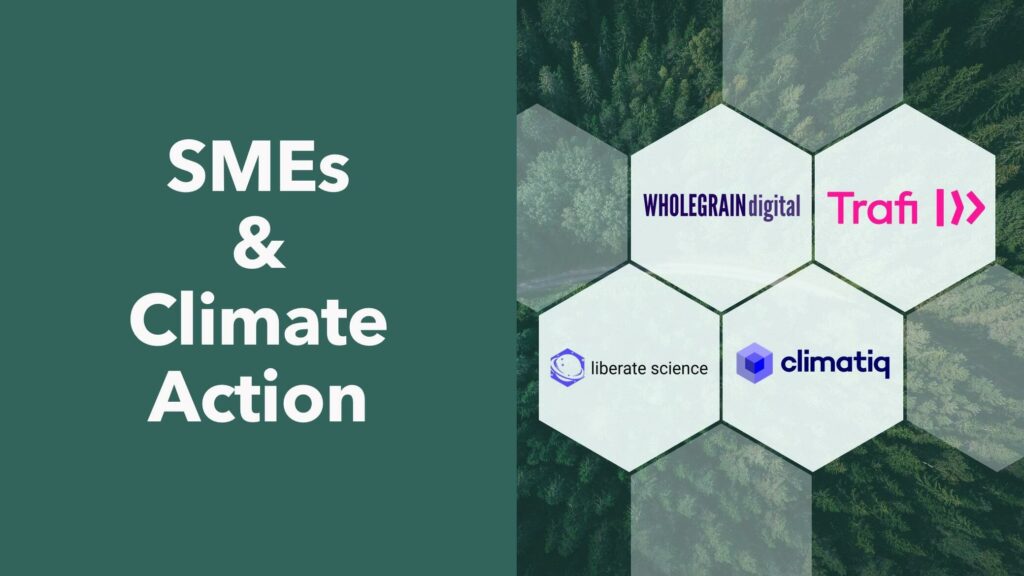
This is a joint publication by Cathleen Berger (Climatiq), Chris Hartgerink (Liberate Science), Indré Blauzdžiūnaitė (Trafi), and Vineeta Greenwood (Wholegrain Digital). It is cross-posted from the Climatiq blog.
We all know that climate action is urgent. We also know that the private sector is responsible for the lion’s share of global greenhouse gas emissions. This is why we feel the need to do our part: assume responsibility, reduce and mitigate our impact, and accelerate global climate action.
Yet, we find ourselves at a conundrum. Though part of the private sector, small and medium-sized enterprises (SMEs) are neither required nor necessarily supported in their sustainability journeys.
Achieving Net Zero: Challenges for SMEs
There are three primary challenges faced by SMEs:
- Lack of scope 3 guidance. Understanding an organisation’s environmental impact generally requires a solid assessment of the amount and the activities that generate emissions. There are direct and indirect emissions (scope 1 and 2) as well as emissions that are accumulated across an organisation’s supply chain (scope 3). Scope 1 and 2 are comparatively straightforward to calculate. However, between 80-99% of overall organisational emissions tend to fall within scope 3. As of now, SMEs are not required to account for their scope 3 emissions — which unfortunately translates into a lack of guidance for how to do so, even voluntarily.
- Lack of clarity and methodologies for digital products. There is significant growth and investments to boost digitisation of products and services, both public and private. To little surprise, the emissions related to the tech and startup sector are noticeably rising. The biggest share of tech-related emissions come from data storage and operations as well as the use of those digital products by end users. Scope 3 Standard of the GHG protocol, the main guideline for scope 3 calculations, does not specify methodologies for digital activities. The situation gets even more complex when it comes to data collection – today, 60% of cloud-based operations are managed by three leading service providers and none of them are openly sharing emissions from networking, memory, compute, data storage, or the lifecycle emissions of servers.
- Lack of net-zero targets applicable to SMEs. Science Based Targets (SBTs), the initiative helping companies to set the goals for carbon reduction, launched a simplified guideline for SMEs in 2020. Ironically enough, the simplification merely cuts away the main “polluter” — scope 3 emissions. In other words, 90% of the footprint of digital SMEs don’t have to be reduced, thus there’s no way for the majority of startups to become net-zero.
One thing should be clear: To meet global targets of staying within the 1.5°C global warming threshold, we need everyone. Including small and medium enterprises.
Best Practices for SME: 4 Examples for Climate Action
As we are continuing to explore the space of scope 3 calculations and reduction, we are stepping up and assuming responsibility as stewards in SMEs. We got together to share best practices, learn from each other, and collaborate to drive change. Practical steps may differ but the direction is very much the same. With this, we hope to pave a way for other SMEs as well.
To illustrate this is how we tackle these challenges in our respective organisations:
- Climatiq: Est: 2021 | Employees: 10 | Headquarter: Berlin, Germany
Climatiq has applied to become a certified B Corporation. In doing so, we are committed to report on all 3 scopes of our emissions publicly and continuously (building on our own science-based backend solution for carbon intelligence). While as an SME we may not get net-zero certified, we will continuously monitor and apply best practices for reduction. - Liberate Science: Est. 2019 | Employees: 2 | Headquarter: Berlin, GermanyDespite only a handful of people in our organization, we estimated our emissions for our first operating year within a matter of hours, with the help of a climate impact expert. The knowhow and thinking about sustainability is business-efficient, once it is available. We need to do more to make that knowledge available to SMEs.
- Trafi: Est: 2014 | Employees: 100 | Headquarter: Vilnius, Lithuania
Besides calculating our digital footprint and removing the emissions that cannot be reduced, Trafi scales the transparency and detail on companies’ scope 3 emissions, with the focus on commuting. We help organisations to view, track and report the impact of their employees’ travel and, most importantly, incentivize sustainable commuting. - Wholegrain Digital: Est: 2007 | Employees: 20 | Location: London, UK
Wholegrain Digital is a certified B Corp, 1% for the planet member, has a Green Handshake policy and aims to be one of the UK’s most sustainable businesses. We estimate our scope 3 emissions and reduce them through innovative initiatives and we offset our CO2 emissions as well. We share our impact and ethics reports. Beyond Scope 3, we also estimate, reduce and offset our client’s digital emissions through championing the creation of low carbon web products. Our Website Carbon calculator project is a part of our knowledge sharing practice that helps others to also measure and reduce their own digital carbon footprint.
Join us and spread the word
The EU Taxonomy will only start applying to SMEs by 2025, though mandatory corporate sustainability reporting currently remains the sole responsibility of larger companies. We want to encourage more SMEs and digital companies to start embarking on this journey now and to hear from those who already did. By 2025, the climate clock will only have four years left. Time’s ticking.
Are you a small or medium sized company committed to climate action? We’d love to hear from you! We welcome additional signatories and invite you to share your experiences with us through this form.
We will follow up with all of you and plan to convene a few best practice sharing sessions in the coming months.
